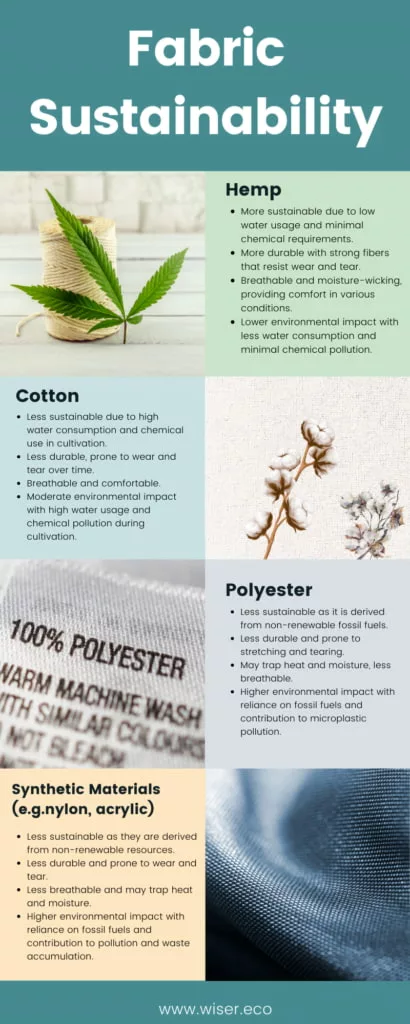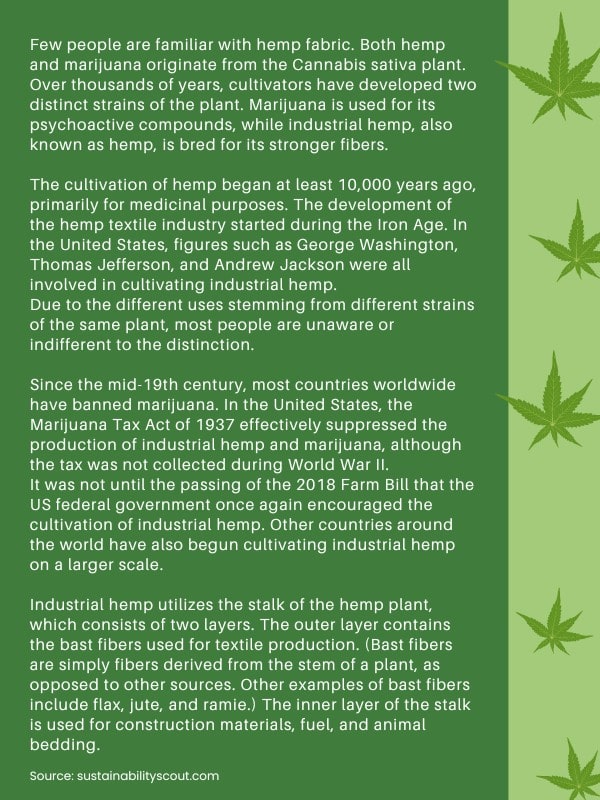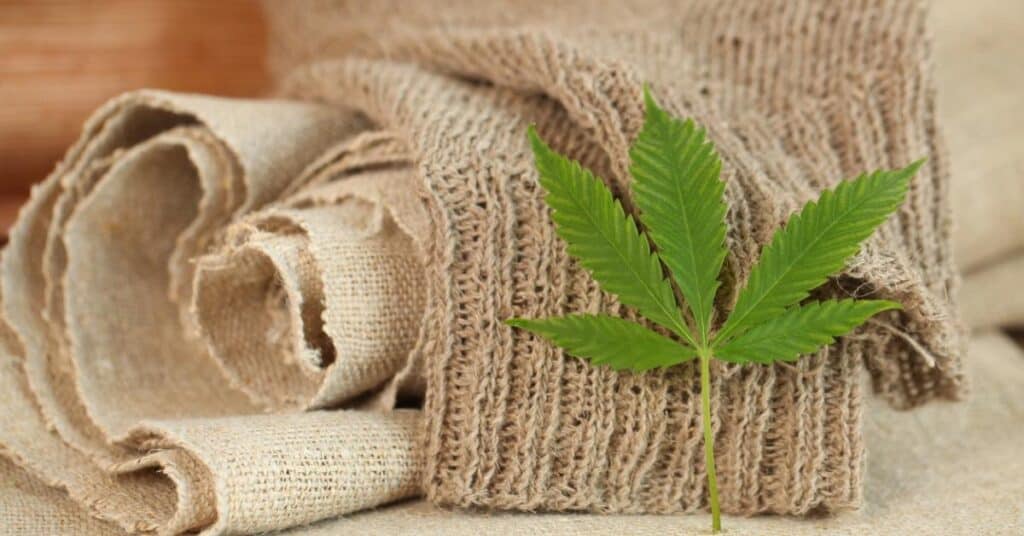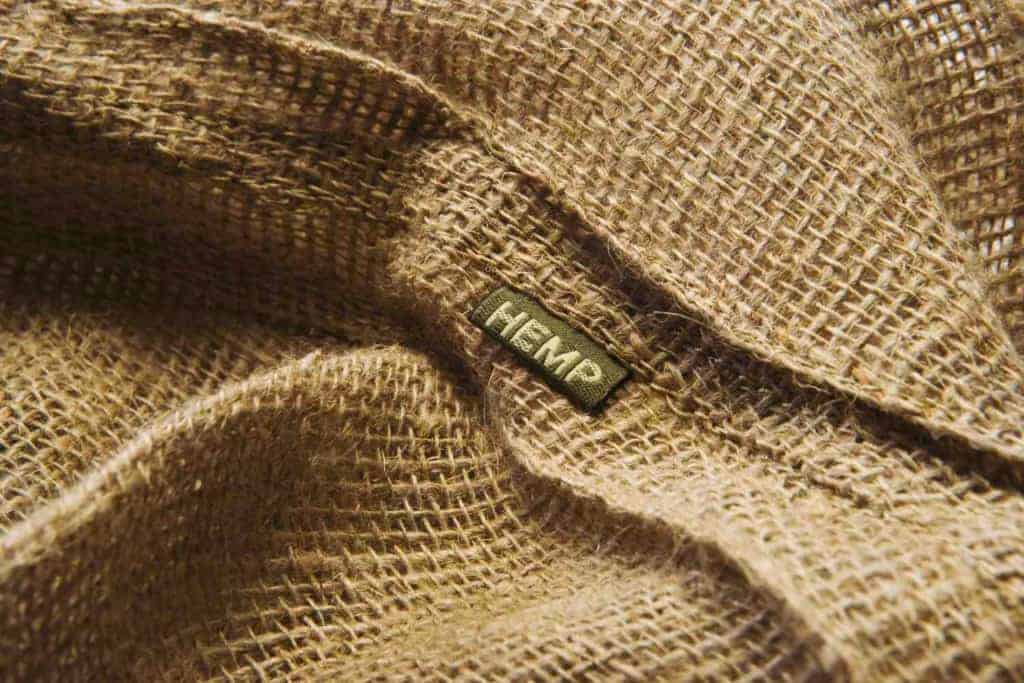In this article, we will uncover the incredible environmental advantages of choosing hemp clothing. From its sustainable cultivation to its minimal water and pesticide requirements, hemp clothing offers a greener alternative to conventional fabrics. Additionally, we will explore how wearing hemp garments can help reduce waste and promote a more eco-friendly fashion industry. So, get ready to discover the many ways in which hemp clothing can make a positive impact on the planet!

This image is property of wiser.eco.
1. Hemp as a Sustainable Crop
1.1. Fast-growing and Low-impact
Hemp is known for being a fast-growing crop, typically reaching maturity within 4-5 months. This rapid growth rate makes it an ideal choice for sustainable farming practices as it requires fewer resources and inputs compared to many other crops. Additionally, the cultivation of hemp has a low environmental impact, as it does not require excessive use of fertilizers or pesticides.
1.2. Less Land and Water Required
Compared to other crops, hemp requires significantly less land and water for cultivation. Its dense growth habit allows it to be planted closely together, maximizing land use efficiency. In fact, hemp can produce double the fiber yield per acre compared to cotton, using only a fraction of the water. This makes it a more sustainable choice for farmers and reduces the strain on water resources.
1.3. No Need for Pesticides or Herbicides
One of the remarkable environmental benefits of hemp cultivation is its natural resistance to pests and weeds. Unlike many other crops, hemp does not require the use of pesticides or herbicides to thrive. This not only reduces the potential harm to ecosystems and wildlife but also results in a healthier end product – free from chemical residues that could have detrimental effects on human health.
2. Carbon Footprint Reduction
2.1. Hemp as a Carbon Sink
Hemp has an incredible capacity to sequester carbon dioxide from the atmosphere, acting as a carbon sink. During its rapid growth, hemp absorbs large amounts of CO2, helping to mitigate the effects of climate change by reducing greenhouse gas emissions. In fact, it has been estimated that one acre of hemp can capture up to 10 tons of CO2, making it an invaluable asset in the fight against global warming.
2.2. Energy-efficient Processing
The processing of hemp fibers into textiles requires significantly less energy compared to other natural fibers such as cotton or synthetic materials like polyester. This energy efficiency further contributes to reducing the carbon footprint associated with the production of hemp clothing. By choosing hemp garments, you are actively supporting a more sustainable and environmentally-friendly fashion industry.
2.3. Reduced Emissions in Comparison to Other Natural Fibers
In addition to being energy-efficient, the production of hemp fibers generates fewer emissions compared to other natural fibers. This is because hemp fibers can be processed without the use of harsh chemicals or extensive bleaching, reducing the release of pollutants into the atmosphere and minimizing the environmental impact of textile production processes.
3. Biodegradability and Durability
3.1. Decomposes Naturally
One of the remarkable characteristics of hemp clothing is its biodegradability. Hemp fibers are entirely natural and can decompose easily without leaving harmful residues in the environment. This is in stark contrast to synthetic fibers like polyester, which can take hundreds of years to break down and contribute to plastic pollution.
3.2. Less Waste Accumulation
Due to its durability, hemp clothing has a longer lifespan compared to many other materials. This means that fewer garments are discarded and end up in landfills. By choosing hemp clothing, you are actively reducing waste accumulation and contributing to a more sustainable approach to fashion.
3.3. Long-lasting and Versatile
Hemp clothing is well-known for its durability and strength. The natural properties of hemp fibers make them resistant to wear and tear, allowing garments to retain their quality and functionality over time. This longevity not only reduces waste but also means that you can enjoy your hemp garments for years to come, making it a cost-effective and sustainable choice.
4. Soil Regeneration and Biodiversity
4.1. Nourishes and Restores Soil
Hemp cultivation has the remarkable ability to nourish and restore soil health. Through a process called phytoremediation, hemp plants draw up toxins and contaminants from the soil, trapping them in their roots and leaves. This natural cleansing process detoxifies the soil, making it fertile once again for future agricultural use. As a result, hemp can be used as a valuable rotational crop, improving overall soil health and preventing the depletion of nutrients.
4.2. Supports Biomass and Wildlife
Hemp fields serve as havens for biodiversity. The dense growth of hemp plants acts as a natural habitat for a variety of beneficial insects, birds, and wildlife, supporting local ecosystems. Furthermore, the biomass produced by hemp plants can be utilized as animal bedding, feed, or even for the production of biofuels, reducing the reliance on non-renewable resources and promoting sustainable practices.
4.3. Prevents Soil Erosion
The extensive root system of hemp plants helps to prevent soil erosion. By anchoring the soil and holding it together, hemp helps to protect against the loss of topsoil due to wind or water erosion. This is crucial for maintaining soil fertility and preventing the degradation of agricultural land, making hemp cultivation an eco-friendly choice for sustainable farming practices.

This image is property of wellfabric.com.
5. Water Conservation
5.1. Lower Water Requirement for Cultivation
Compared to cotton, hemp requires significantly less water for cultivation. This is particularly important in regions where water scarcity is a concern. By opting for hemp clothing, you are actively supporting water conservation efforts and reducing the strain on limited water resources.
5.2. Reduced Water Pollution in Processing
The processing of hemp fibers into textiles also contributes to water conservation. Unlike synthetic fibers like polyester, hemp fibers can be processed without using toxic chemicals, minimizing the pollution of water sources and protecting aquatic ecosystems. This makes hemp clothing a more sustainable choice that aligns with responsible water stewardship.
5.3. Less Water Usage during Garment Care
Hemp clothing is also beneficial when it comes to your daily garment care routine. The natural properties of hemp fibers make them more resistant to staining and dirt, meaning you can reduce the frequency of washing compared to other materials. This leads to less water usage and helps to conserve water resources.
6. Less Chemical Usage
6.1. Natural Fiber Production
Hemp fibers are naturally derived and do not require the heavy use of chemicals during their production. This contrasts with the production of synthetic fibers, which often involve the use of petroleum-based chemicals and toxins. By choosing hemp clothing, you are opting for a more natural and sustainable alternative that is better for both the environment and your skin.
6.2. Safer Labor Conditions
The reduced need for chemical inputs in hemp cultivation and processing also leads to safer labor conditions. Workers involved in the production of hemp clothing are not exposed to harmful pesticides or other hazardous substances, ensuring their well-being and minimizing occupational health risks. Supporting the hemp industry means supporting ethical and responsible labor practices.
6.3. Minimized Environmental Contamination
The use of fewer chemicals in hemp cultivation and textile production not only benefits workers but also minimizes environmental contamination. By reducing the release of harmful pollutants and toxins into the air, water, and soil, hemp clothing helps to protect ecosystems and safeguard the planet for future generations.

This image is property of media.greenmatters.com.
7. Hemp’s Potential as a Crop Rotation Option
7.1. Rotational Crop to Improve Soil Health
Hemp has significant potential as a rotational crop in sustainable farming systems. Its deep root system helps break up compacted soil, improving its structure and allowing for better water infiltration. Additionally, hemp’s phytoremediation properties make it an excellent choice for cleaning up contaminated soil, further improving soil health and fertility.
7.2. Natural Pest Control and Disease Resistance
Integrating hemp into crop rotation strategies can also help control pests and diseases. Hemp plants naturally repel certain insects, reducing the need for chemical pesticides. Additionally, hemp’s disease resistance properties can benefit other crops in the rotation, reducing the overall reliance on synthetic inputs and promoting a more sustainable and eco-friendly approach to farming.
7.3. Diversified Farming Practices
The inclusion of hemp in crop rotation plans promotes diversified farming practices, which have numerous environmental benefits. Diversification helps to maintain and enhance biodiversity, improve soil fertility, and reduce the risk of crop failure. As a result, farmers can reduce their dependency on synthetic inputs and achieve more sustainable and resilient agricultural systems.
8. Hemp Fiber Recycling
8.1. Closed-loop System for Textile Waste
Hemp fibers can be effectively recycled and reused, creating a closed-loop system for textile waste. Unlike synthetic fibers that often end up in landfills, hemp clothing can be broken down and processed into new fibers, reducing the demand for virgin materials, conserving resources, and minimizing waste.
8.2. Reduced Demand for Virgin Fibers
By supporting the recycling of hemp fibers, you are actively reducing the demand for virgin fibers. Virgin fibers, whether natural or synthetic, require significant resources to produce, including water, energy, and raw materials. By embracing hemp fiber recycling, we can achieve a more circular economy, reducing the need for resource-intensive production processes.
8.3. Minimized Waste to Landfills
The recycling of hemp fibers helps to minimize the amount of textile waste ending up in landfills. By diverting waste from disposal sites, we can reduce the environmental impact of waste management and contribute to a more sustainable waste management system. Additionally, recycling hemp fibers also reduces the release of harmful pollutants associated with the decomposition of textiles in landfills.

This image is property of wiser.eco.
9. Economic and Social Benefits
9.1. Increased Job Opportunities
The growth of the hemp industry creates new job opportunities, particularly in rural areas. Hemp cultivation, processing, and manufacturing require a skilled workforce, providing employment opportunities for local communities. Supporting the hemp clothing industry means supporting sustainable job creation and economic growth.
9.2. Support for Local and Sustainable Industries
By choosing hemp clothing, you are supporting local and sustainable industries. Hemp cultivation and processing can be done on a smaller scale, providing opportunities for local farmers and businesses to thrive. This promotes local economies and reduces the reliance on large-scale industrial production that can have negative social and environmental impacts.
9.3. Potential for Rural Development
The cultivation of hemp has the potential to revitalize rural areas, contributing to rural development and improving the livelihoods of farming communities. As a versatile crop with numerous applications, hemp allows for diversification and resilience in agricultural systems, reducing the vulnerability of rural communities to market fluctuations and climate change. By embracing hemp as a sustainable crop, we can foster rural development and create more balanced and prosperous societies.
10. Conclusion
Hemp clothing offers a plethora of environmental benefits, making it a sustainable and responsible choice for conscious consumers. From its fast-growing and low-impact nature to its carbon footprint reduction and soil regeneration properties, hemp shines as a versatile crop with immense potential for a greener future. By selecting hemp clothing, you actively contribute to water conservation, reduced chemical usage, and the promotion of circular economies. Additionally, the economic and social benefits of the hemp industry cannot be overlooked, as it supports local industries, creates job opportunities, and fosters rural development. In conclusion, by embracing hemp clothing, you become an agent of change, promoting a more sustainable and environmentally-friendly fashion industry.
This image is property of i.shgcdn.com.
Recent Posts
Discover how bubble hash is rated on a 1 to 6 scale. From texture and color to aroma and potency, learn the key factors that determine the quality of bubble hash. Whether you're a seasoned cannabis...
Looking to learn about the most popular style of hash? This article explores the different types, from traditional to bubble hash, and reveals the people's favorite. Join us on a journey through the...

